The NVIDIA GeForce GTX 980 Review: Maxwell Mark 2
by Ryan Smith on September 18, 2014 10:30 PM ESTDisplay Matters: HDMI 2.0, HEVC, & VR Direct
Stepping away from the graphics heart of Maxwell 2 for a bit, NVIDIA has been busy not just optimizing their architecture and adding graphical features to their hardware, but they have also added some new display-oriented features to the Maxwell 2 architecture. This has resulted in an upgrade of their video encode capabilities, their display I/O capabilities, and even their ability to drive virtual reality headsets such as the Oculus Rift.
We’ll start first with display I/O. HDMI users will be happy to see that as of GM204, NVIDIA now supports HDMI 2.0, which will allow NVIDIA to drive future 4K@60Hz displays over HDMI and without compromise. HDMI 2.0 for its part is the 4K-focused upgrade of the HDMI standard, and brings with it support for the much higher data rate (through a greatly increased clockspeed of 600MHz) necessary to drive 4K displays at 60Hz, while also introducing features such as new subsampling patterns like YCbCr 4:2:0, and official support for wide aspect ratio (21:9 displays).
It should be noted that this is full HDMI 2.0 support, and as a result it notably differs from the earlier support that NVIDIA patched into Kepler and Maxwell 1 through drivers. Whereas NVIDIA’s earlier update was to allow these products to drive a 4K@60Hz display using 4:2:0 subsampling to stay within the bandwidth limitations of HDMI 1.4, Maxwell 2 implements the bandwidth improvements necessary to support 4K@60Hz with full resolution 4:4:4 and RGB color spaces.
Given the timeline for HDMI 2.0 development, the fact that we’re seeing HDMI 2.0 support now is if anything a pleasant surprise, since it’s earlier than we expected it. However this will leave HTPC users in a pickle if they want HDMI 2.0 support; with the GM107 based GTX 750 series having launched only 7 months ago without HDMI 2.0 support, we would not expect NVIDIA’s HTPC-centric video cards to be replaced any time soon. This means the only option for HTPC users wanting HDMI 2.0 support right away is to upgrade to a larger and more powerful Maxwell 2 based card, or otherwise stick to the low powered GTX 750 series and go without HDMI 2.0.
Meanwhile alongside the upgrade to HDMI 2.0, NVIDIA has also made one other change to their display controllers that should be of interest to multi-monitor users. With Maxwell 2, a single display controller can now drive multiple identical MST substreams on its own, rather than requiring a different display controller for each stream. This feature will be especially useful for driving tiled monitors such as many of today’s 4K monitors, which are internally a pair of identical displays driven using MST. By being able to drive both tiles off of a single display controller, NVIDIA can make better use of their 4 display controllers, allowing them to drive up to 4 such displays off of a Maxwell 2 GPU as opposed to the 2 display limitation that is inherent to Kepler GPUs. For the consumer cards we’re seeing today, the most common display I/O configuration will include 3 DisplayPorts, allowing these specific cards to drive up to 3 such 4K monitors.
HEVC & 4K Encoding
In Maxwell 1, NVIDIA introduced updated versions of both their video encode and decode engines. On the decode side the new VP6 decoder increased the performance of the decode block to allow NVIDIA to decode H.264 up to 4K@60Hz (Level 5.2), something the older VP5 decoder was not fast enough to do. Meanwhile the Maxwell 1 NVEC video encoder received a similar speed boost, roughly doubling its performance compared to Kepler.
Surprisingly, even after only 7 months since the first Maxwell 1 GPUs, NVIDIA has once again overhauled NVENC, and this time more significantly. The Maxwell 2 version of NVENC further builds off of the Maxwell 1 NVENC by adding full support for HEVC (H.265) encoding. Like HDMI 2.0 support, this marks the very first PC GPU we’ve seen integrate support for this more advanced codec.
At this point there’s really not much that can be done with Maxwell 2’s HEVC encoder – it’s not exposed in anything or used in NVIDIA’s current tools – but NVIDIA is laying the groundwork for the future once HEVC support becomes more commonplace in other hardware and software. NVIDIA envisions their killer app for HEVC support to be game streaming, where the higher efficiency of HEVC will improve the image quality of game streams due to the limited bandwidth available in most streaming scenarios. In the long run we would expect NVIDIA to utilize HEVC for GameStream for the home, and at the server level support for HEVC in the next generation of GRID cards will be a major boon to NVIDIA’s GRID streaming efforts.
Meanwhile where the enhanced version of NVENC is going to be applicable today is in ShadowPlay. While still recording in H.264, the higher performance of NVENC means that NVIDIA can now offer recording at higher resolutions and bitrates. With GM204 NVIDIA’s hardware can now record at 1440p60 and 4Kp60 at bitrates up to 130Mbps, as opposed to the 1080p60 @ 50Mbps limit for their Kepler cards.
Finally, and somewhat paradoxically, Maxwell 2 inherits Kepler and Maxwell 1’s hybrid HEVC decode support. First introduced with Maxwell 1 and backported to Kepler, NVIDIA’s hybrid HEVC decode support enables HEVC decoding on these parts by using a combination of software (shader) and hardware decoding, leveraging the reusable portions of the H.264 decode block to offload to fixed function hardware what elements it can, and processing the rest in software.
A hybrid decode process is not going to be as power efficient as a full fixed function decoder, but handled in the GPU it will be much faster and more power efficient than handling the process in software. The fact that Maxwell 2 gets a hardware HEVC encoder but a hybrid HEVC decoder is in turn a result of the realities of hardware development for NVIDIA; you can’t hybridize encoding, and the hybrid decode process is good enough for now. So NVIDIA spent their efforts on getting hardware HEVC encoding going first, and at this point we’d expect to see full hardware HEVC decoding show up in a future generation of hardware (and we’d note that NVIDIA can swap VP blocks at will, so it doesn’t necessarily have to be Pascal).
VR Direct
Our final item on the list of NVIDIA’s new display features is a family of technologies NVIDIA is calling VR Direct.
VR Direct in a nutshell is a collection of technologies and software enhancements designed to improve the experience and performance of virtual reality headsets such as the Oculus Rift. From a practical perspective NVIDIA already has some experience in stereoscopic rendering through 3D Vision, and from a marketing perspective the high resource requirements of VR would be good for encouraging GeForce sales, so NVIDIA will be heavily investing into the development of VR technologies through VR Direct.
From a technical perspective the biggest thing that Oculus and other VR headset makers need from GPU manufacturers and the other companies involved in the PC ecosystem is methods of reducing the latency/input lag between a user’s input and when a finished frame becomes visible on a headset. While some latency is inevitable – it takes time to gather data and render a frame – the greater the latency the greater the disconnect will be between the user and the rendered world. In more extreme cases this can make the simulation unusable, or even trigger motion sickness in individuals whose minds can’t handle the disorientation from the latency. As a result several of NVIDIA’s features are focused on reducing latency in some manner.
First and foremost, for VR headsets NVIDIA has implemented a low latency mode that minimizes the amount of time a frame spends being prepared by the drivers and OS. In an average case this low latency mode eliminates 10ms of OS-induced latency from the rendering pipeline, and this is the purest optimization of the bunch.
Meanwhile at the more extreme end of the feature spectrum, NVIDIA will be supporting a feature called asynchronous warp. This feature, known by Oculus developers as time warp, involves rendering a frame and then at the last possible moment updating the head tracking information from the user. After that information is acquired, the nearly finished frame then has a post-process warping applied to it to take into account head movement since the frame was initially submitted, with the ultimate goal of this warping being the simulation of what the frame should look like had it been rendered instantaneously.
From a quality perspective asynchronous warp stands to be a bit of a kludge, but it is the single most potent latency improvement among the VR Direct feature set. By modifying the frame to account for the user’s head position as late as is possible, it reduces the perceived latency by as much as 25ms.
NVIDIA’s third latency optimization is less a VR optimization and more a practical effect of an existing technology, and that is Multi-Frame sampled Anti-Aliasing. As we'll discuss later in our look at this new AA mode, Multi-Frame sampled Anti-Aliasing is designed to offer 4x MSAA-like quality with 2x MSAA-like performance. Assuming a baseline of 4x MSAA, switching it out for Multi-Frame sampled Anti-Aliasing can shave an additional few milliseconds off of the frame rendering time.
Lastly, NVIDIA’s fourth and final latency optimization for VR Direct is VR SLI. And this feature is simple enough: rather than using alternate frame rendering (AFR) to render both eyes at once on one GPU, split up the workload such that each GPU is working on each eye simultaneously. AFR, though highly compatible with traditional monoscopic rendering, introduces additional latency that would be undesirable for VR. By rendering each eye separately on each GPU, NVIDIA is able to apply the performance benefits of SLI to VR without creating additional latency. Given the very high performance and low latencies required for VR, it’s currently expected that most high-end games supporting VR headsets will need SLI to achieve their necessary performance, so being able to use SLI without a latency penalty will be an important part of making VR gaming commercially viable.
On a side note, for the sake of clarity we do want to point out that many of NVIDIA’s latency optimizations come from the best practices suggestions of Oculus VR. Asynchronous warp and OS level latency optimizations for example are features that Oculus VR is suggesting for hardware developers and/or pursuing themselves. So while these features are very useful to have on GeForce hardware, they are not necessarily all ideas that NVIDIA has come up with or technologies that are limited to NVIDIA hardware (or even the Maxwell 2 architecture).
Moving on, other than NVIDIA’s latency reduction technologies the VR Direct feature set will also include some feature improvements designed to improve the quality and usability of VR. NVIDIA’s Dynamic Super Resolution (DSR) technology will be available to VR, and given the physical limits on pixel density in today’s OLED panels it will be an important tool in reducing perceptible aliasing. NVIDIA will also be extending VR support to GeForce Experience at a future time, simplifying the configuration of VR-enabled games. For VR on GeForce Experience NVIDIA wants to go beyond just graphical settings and also auto-configure inputs as well, handling remapping of inputs to head/body tracking for the user automatically.
Ultimately at this point VR Direct is more of a forward looking technology than it is something applicable today – the first consumer Oculus Rift hasn’t even been announced, let alone shipped – but by focusing on VR early NVIDIA is hoping to improve the speed and ease of VR development, and have the underpinnings in place once consumer VR gear becomes readily available.


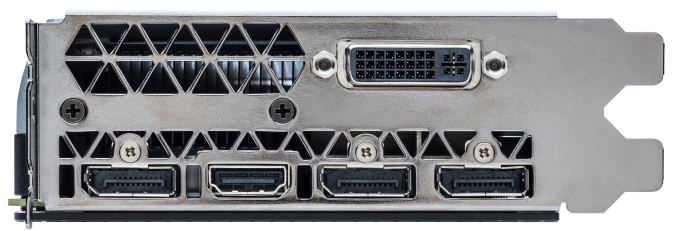
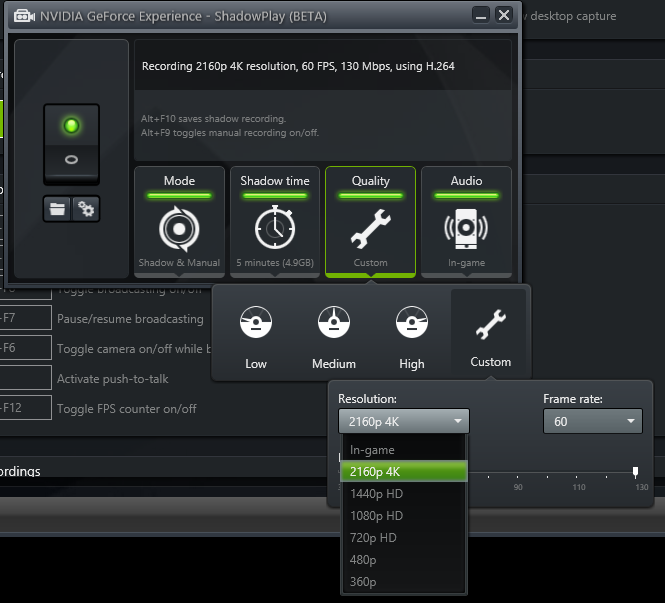
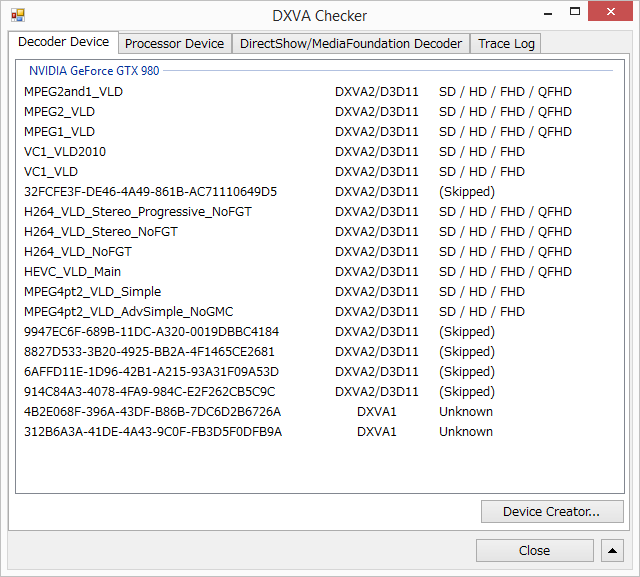
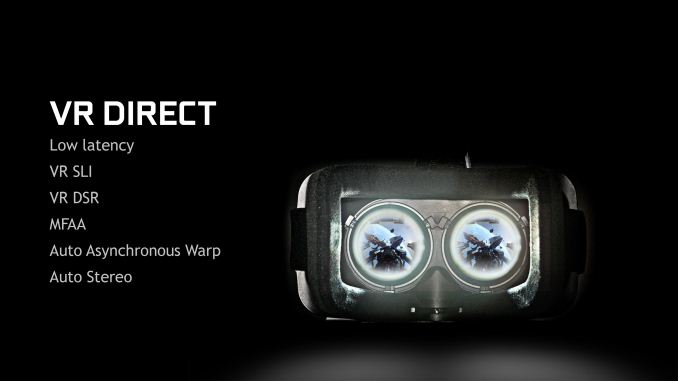
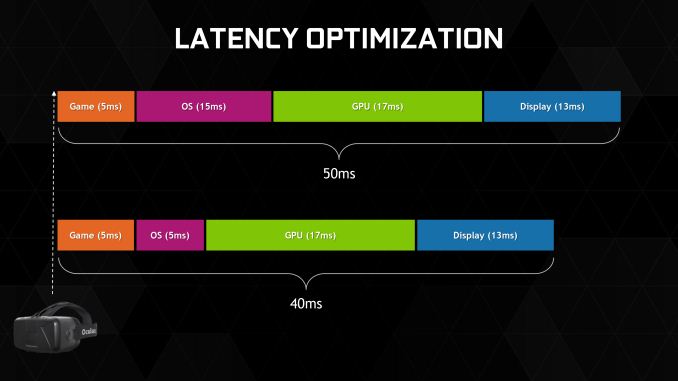
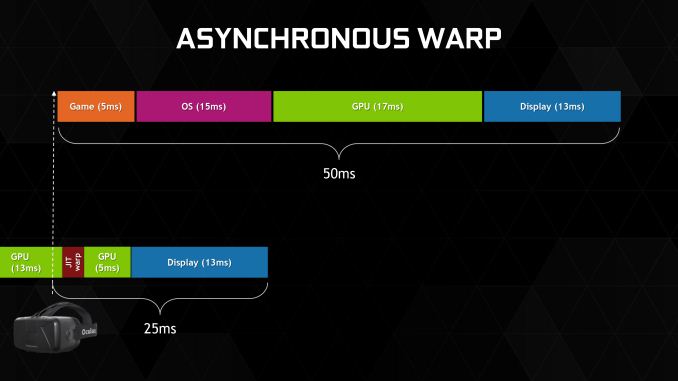








274 Comments
View All Comments
garadante - Sunday, September 21, 2014 - link
What might be interesting is doing a comparison of video cards for a specific framerate target to (ideally, perhaps it wouldn't actually work like this?) standardize the CPU usage and thus CPU power usage across greatly differing cards. And then measure the power consumed by each card. In this way, couldn't you get a better example ofgaradante - Sunday, September 21, 2014 - link
Whoops, hit tab twice and it somehow posted my comment. Continued:couldn't you get a better example of the power efficiency for a particular card and then meaningful comparisons between different cards? I see lots of people mentioning how the 980 seems to be drawing far more watts than it's rated TDP (and I'd really like someone credible to come in and state how heat dissipated and energy consumed are related. I swear they're the exact same number as any energy consumed by transistors would, after everything, be released as heat, but many people disagree here in the comments and I'd like a final say). Nvidia can slap whatever TDP they want on it and it can be justified by some marketing mumbo jumbo. Intel uses their SDPs, Nvidia using a 165 watt TDP seems highly suspect. And please, please use a nonreference 290X in your reviews, at least for a comparison standpoint. Hasn't it been proven that having cooling that isn't garbage and runs the GPU closer to high 60s/low 70s can lower power consumption (due to leakage?) something on the order of 20+ watts with the 290X? Yes there's justification in using reference products but lets face it, the only people who buy reference 290s/290Xs were either launch buyers or people who don't know better (there's the blower argument but really, better case exhaust fans and nonreference cooling destroys that argument).
So basically I want to see real, meaningful comparisons of efficiencies for different cards at some specific framerate target to standardize CPU usage. Perhaps even monitoring CPU usage over the course of the test and reporting average, minimum, peak usage? Even using monitoring software to measure CPU power consumption in watts (as I'm fairly sure there are reasonably accurate ways of doing this already, as I know CoreTemp reports it as its probably just voltage*amperage, but correct me if I'm wrong) and reported again average, minimum, peak usage would be handy. It would be nice to see if Maxwell is really twice as energy efficient as GCN1.1 or if it's actually much closer. If it's much closer all these naysayers prophesizing AMD's doom are in for a rude awakening. I wouldn't put it past Nvidia to use marketing language to portray artificially low TDPs.
silverblue - Sunday, September 21, 2014 - link
Apparently, compute tasks push the power usage way up; stick with gaming and it shouldn't.fm123 - Friday, September 26, 2014 - link
Don't confuse TDP with power consumption, they are not the same thing. TDP is for designing the thermal solution to maintain the chip temperature. If there is more headroom in the chip temperature, then the system can operate faster, consuming more power."Intel defines TDP as follows: The upper point of the thermal profile consists of the Thermal Design Power (TDP) and the associated Tcase value. Thermal Design Power (TDP) should be used for processor thermal solution design targets. TDP is not the maximum power that the processor can dissipate. TDP is measured at maximum TCASE"
https://www.google.com/url?sa=t&source=web&...
NeatOman - Sunday, September 21, 2014 - link
I just realized that the GTX 980 has a TDP of 165 watts, my Corsair CX430 watt PSU is almost overkill!, that's nuts. That's even enough room to give the whole system a very good stable overclock. Right now i have a pair of HD 7850's @ stock speed and a FX-8320 @ 4.5Ghz, good thing the Corsair puts out over 430 watts perfectly clean :)Nfarce - Sunday, September 21, 2014 - link
While a good power supply, you are leaving yourself little headroom with 430W. I'm surprised you are getting away with it with two 7850s and not experiencing system crashes.ET - Sunday, September 21, 2014 - link
The 980 is an impressive feat of engineering. Fewer transistors, fewer compute units, less power and better performance... NVIDIA has done a good job here. I hope that AMD has some good improvements of its own under its sleeve.garadante - Sunday, September 21, 2014 - link
One thing to remember is they probably save a -ton- of die area/transistors by giving it only what, 1/32 double precision rate? I wonder how competitive in terms of transistors/area an AMD GPU would be if they gutted double precision compute and went for a narrower, faster memory controller.Farwalker2u - Sunday, September 21, 2014 - link
I am looking forward to your review of the GTX 970 once you have a compatible sample in hand.I would like to see the results of the Folding @Home benchmarks. It seems that this site is the only one that consistently use that benchmark in its reviews.
As a "Folder" I'd like to see any indication that the GTX 970, at a cost of $330 and drawing less watts than a GTX 780; may out produce both the 780 ($420 - $470) and the 780Ti ($600). I will be studying the Folding @ Home: Explicit, Single Precision chart which contains the test results of the GTX 970.
Wolfpup - Monday, September 22, 2014 - link
Wow, this is impressive stuff. 10% more performance from 2/3 the power? That'll be great for desktops, but of course even better for notebooks. Very impressed they could pulll off that kind of leap on the same process!They've already managed to significantly bump up the top end mobile part from GTX 680 -> 880, but within a year or so I bet they can go quite a bit higher still.
Oh well, it was nice having a top of the line mobile GPU for a while LOL
If 28nm hit in 2012 though, doesn't that make 2015 its third year? At least 28nm seems to be a really good process, vs all the issues with 90/65nm, etc., since we're stuck on it so long.
Isn't this Moore's Law hitting the constraints of physical reality though? We're taking longer and longer to get to progressively smaller shrinks in die size, it seems like...
Oh well, 22nm's been great with Intel and 28's been great with everyone else!